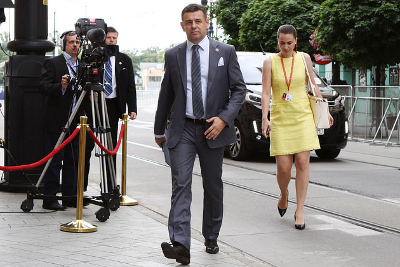Proposal for greenhouse gas reductions in the non-ETS sectors is judged ambitious by the Slovak Environment Minister.
When it comes to the emissions reduction, the Slovak Presidency knows the cards it will have to play with in the Council of the European Union.
The European Commission proposed in July the binding national targets for the sectors outside the EU Emissions Trading System (ETS). The legislative initiatives on the ETS as well as on the non-ETS sectors will dominate the agenda of the European environment ministers during the following five months.
Slovakia could test its waters as it chaired the first ministerial debate on environment in July – an informal Council meeting in Bratislava. And it wants a legacy; following the Bratislava meeting, it called for swift ratification of the Paris Agreement by Member States and announced it will do so itself before the November COP22 in Marrakech, which is earlier than it had planned.
Towards 40-percent cuts by 2030
The sectors outside the ETS such as transport, buildings, agriculture and forestry account for 60 percent of EU’s greenhouse gas emissions.
The Commission has proposed to cut the non-ETS emissions by 30 percent between 2021 and 2030 (in 2005 levels). The ambition represents a significant shift from the 2020 target, which is currently at -10 percent (since 2005).
Together with the federalized ETS (45 percent of the total) covering mostly emissions from the power and industry, the effort should lead the EU towards the overall 40-percent CO2 cuts in by 2030.
This is the ambition which EU committed to in the Paris Agreement on minimizing the temperature increase between the 1850s and 2100 to 2 degrees Celsius.
Merciful or ambitious targets?
Based mainly on the GDP, the Commission proposal for the non-ETS sectors is merciful for the Visegrad Group, according to green groups. Between 2021 and 2030, the Czech Republic should decrease emissions by 14 percent, Slovakia by 12 and Hungary and Poland’s by 7. Numerous Western nations are demanded to reduce emissions by 37 – 40 percent.
The first reaction of Slovak Environment Minister László Sólymos was rather critical. “It is a very ambitious target,” Sólymos, who chairs the Environment Ministers meetings, told SETPLAN2016.sk. “For Slovakia it implies de iure reduction of emissions after 2020 by 25 percent”.
By 2020, Slovakia may increase emissions by 13 percent (compared to 2005). The increase plus the post-2030 decrease by 12 percent (compared to 2005) equals a decrease by 25-percent. According to the same logic, post-2020 the other Visegrad countries will have to make 17 – 23 reductions.
Limited flexibilities
Moreover, the Visegrad countries can benefit very little from the new flexibilities facilitating the effort.
They cannot use at all the possibility to count up ETS credits worth of 100 million tons of CO2. And their manoeuvring space for crediting the emissions reductions from the land use, land-use change and forestry (LULUCF) worth 280 million tons of CO2 against the non-ETS targets is very limited.
“We welcome the introduction of the new flexibility instruments, although we do not consider the overall 280 million tons of CO2 for the EU in LULUCF a sufficient flexibility, which would help towards a greater support for the sustainable forest and land management in the long term,” said Minister Sólymos for SETPLAN2016.sk.
During the following five months of the Slovak Presidency, Sólymos wants to focus on the impact assessment of the proposed measures, including “impact on the economy”. The ministerial debate will resume in October.
Reforming the ETS
The reform of the ETS hindered by surplus of allowances remains a challenging task for the Slovak Presidency. In its programme, it committed to reaching a general approach in the EU Council.
When asked by SETPLAN2016.sk about the hot issues, the Minister said “the most discussed issue can also be the ratio of allowances for auction and for non-reimbursable allocation.” The currently proposed ratio is at 57:43, though “the methodology is not clear.”
The other issues which are subject to debate include funding. The innovation fund “should support innovations in the low-carbon industrial technologies and processes as well as projects in the field of renewable energy sources,” according to Sólymos.
“The modernisation fund is for the low-income Member States,” the Minister explained, “and should contribute to emissions reduction… especially in the energy sector.”

 __
__
 _
_
 _
_ _
_